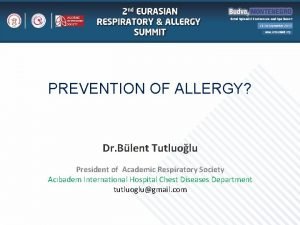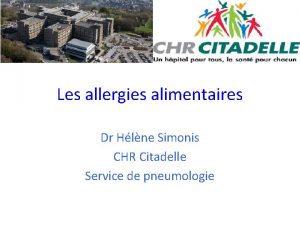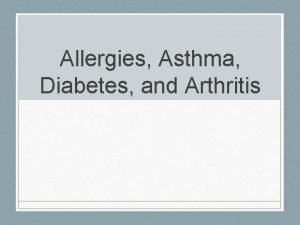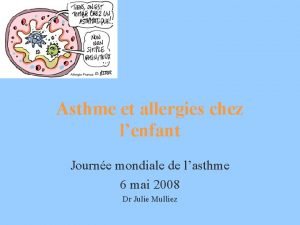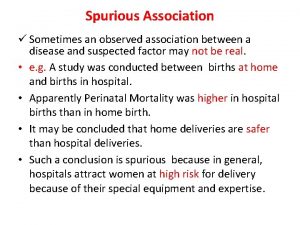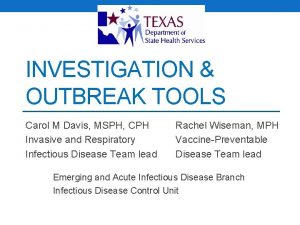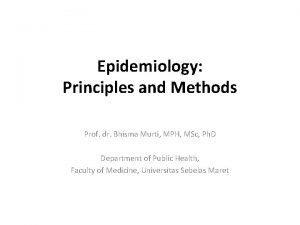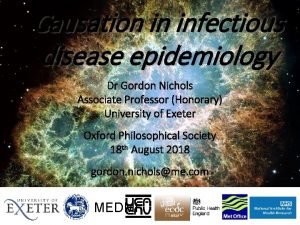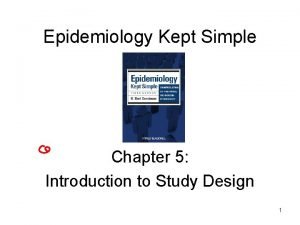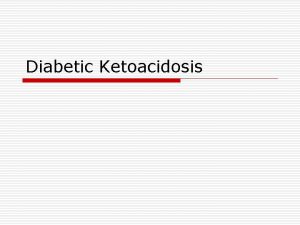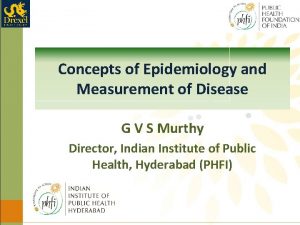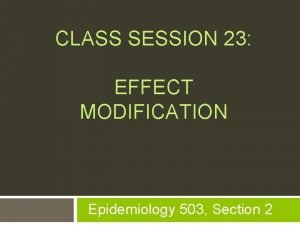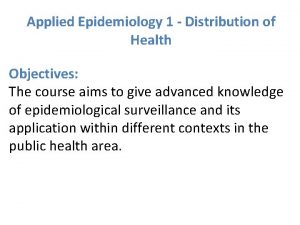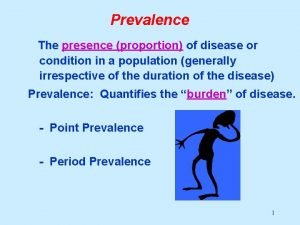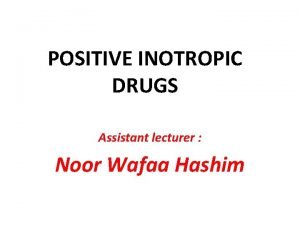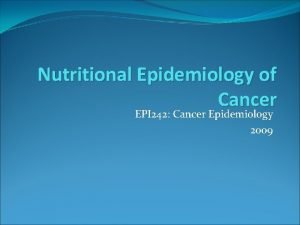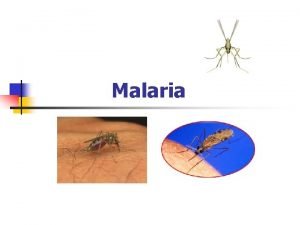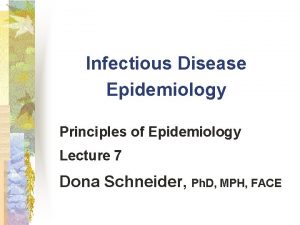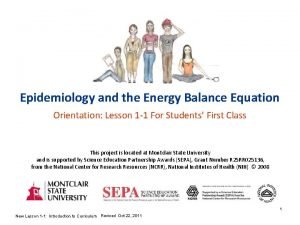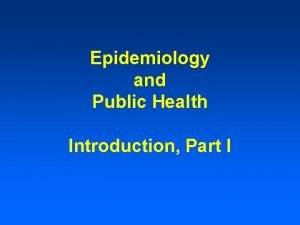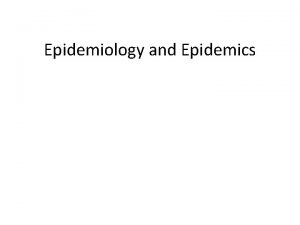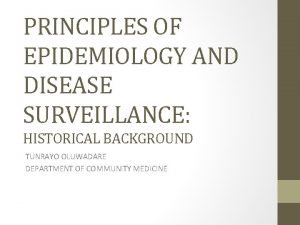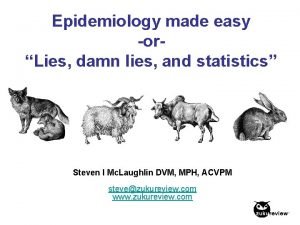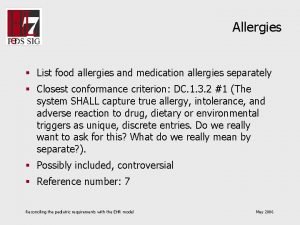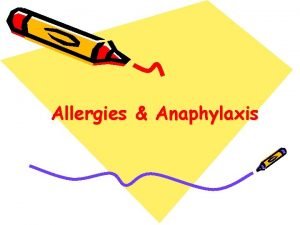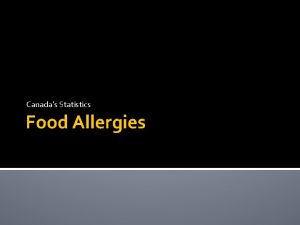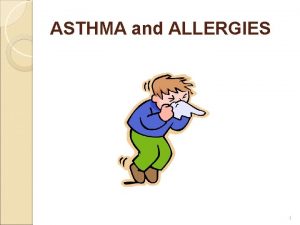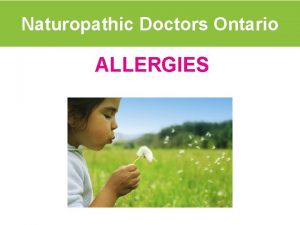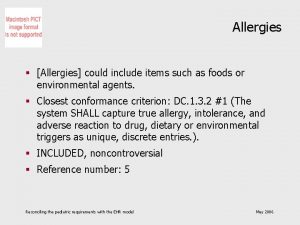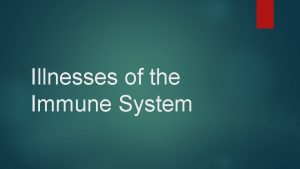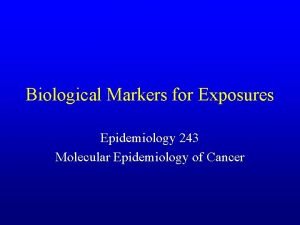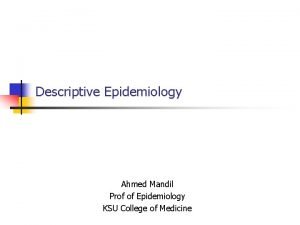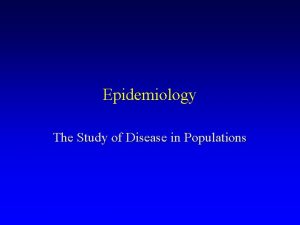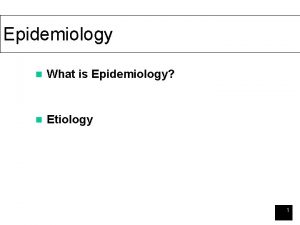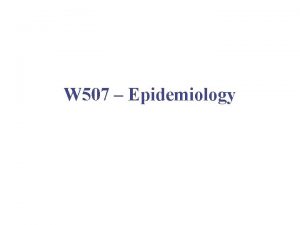Allergies across the world epidemiology of allergies Dr

















































- Slides: 49


Allergies across the world (epidemiology of allergies) Dr Michael Perkin Consultant in Paediatric Allergy & Senior Lecturer in Clinical Epidemiology Dubrovnik, 17 th March 2018

Disclosure In relation to this presentation, I declare the following, real or perceived conflicts of interest: Type Company Employment full time / part time None Spouse / Family member employment / engagement None Research Grant (P. I. , collaborator or consultant; pending and received grants) None Other research support None Speakers Bureau / Honoraria None Ownership interest (stock, stockoptions, patent or intellectual property) None Consultant / advisory board None A conflict of interest is any situation in which a speaker or immediate family members have interests, and those may cause a conflict with the current presentation. Conflicts of interest do not preclude the delivery of the talk, but should be explicitly declared. These may include financial interests (e. g. owning stocks of a related company, having received honoraria, consultancy fees), research interests (research support by grants or otherwise), organisational interests and gifts. EAACI dedicated to Allergy Science, committed to your Health 3

1820 s: Catarrhus aestivus

1820 s: Catarrhus aestivus 1819 – 1 case John Bostock describes his own “periodical affection of the eyes and chest” 1828 – 28 cases "It is remarkable, that all cases are in the middle and upper classes of society, some indeed of high rank… I have not heard of a single unequivocal case among the poor. "

The Allergy Epidemic Blackley 1873 “It would seem that hay-fever has, of late years, been considerably on the increase…. . The persons most subjected to the action of the pollen belong to a class which furnishes the fewest cases of the disorder, namely, the farming class. ” Blackley CH. Experimental researches on the causes and nature of Catarrhus aestivus (hay-fever or hay-asthma). 1873


The Allergy Epidemic Gerrard 1976 Metis Native American Community

The Allergy Epidemic Gerrard 1976 Helminths Metis Urticaria White Eczema Recurrent bronchitis Recurrent rhinitis Hay fever Asthma 0 5 10 Percentage 15 20 25

The Allergy Epidemic Gerrard 1976 “It is suggested that atopic disease is the price paid by some members of the white community for their relative freedom from diseases due to viruses, bacteria and helminths” Gerrard JW et al. Annals of Allergy, 1976

The Emergence of the Hygiene Hypothesis Barker 1985 “Barker attributed the rise in appendicitis to improvements in water supplies and sewage and refuse disposal during the late nineteenth century. These improvements in hygiene greatly reduced the exposure of infants and children to enteric organisms, which in turn modified response to later virus infections, so that they now triggered appendicitis. ” Barker DJ. Acute appendicitis and dietary fibre: an alternative hypothesis. BMJ, 1985

The Emergence of the Hygiene Hypothesis Barker 1985 Relative risk of appendicitis 3. 5 3. 0 2. 5 2. 0 1. 5 1. 0 0. 5 0 1 2 3 Children under 16 4+

The Hygiene Hypothesis Strachan 1989 25 Current hay fever aged 23 Current hay fever aged 11 Adjusted percentage 20 Eczema in first year of life 15 10 5 0 0 1 2 Number of older children 3 4+

The Hygiene Hypothesis The facts “…could be explained if allergic diseases were prevented by infection in early childhood…” BMJ 1989; 299: 1259– 60

The Hygiene Hypothesis - Conclusions • Viral infections, particularly of the respiratory tract, are not important precipitants of the expression of atopy • Infections transmitted by unhygienic contact with older siblings • Or acquired prenatally from a mother infected by contact with her older children • Later infection/re-infection by younger siblings might confer additional protection BMJ 1989; 299: 1259– 60

The Hygiene Hypothesis - Conclusions • Viral infections, particularly of the respiratory tract, are not important precipitants of the expression of atopy • Infections transmitted by unhygienic contact with older siblings • Or acquired prenatally from a mother infected by contact with her older children • Later infection/re-infection by younger siblings might confer additional protection BMJ 1989; 299: 1259– 60

The Hygiene Hypothesis - Conclusions • Viral infections, particularly of the respiratory tract, are not important precipitants of the expression of atopy • Infections transmitted by unhygienic contact with older siblings • Or acquired prenatally from a mother infected by contact with her older children • Later infection/re-infection by younger siblings might confer additional protection BMJ 1989; 299: 1259– 60

The Hygiene Hypothesis - Conclusions • Viral infections, particularly of the respiratory tract, are not important precipitants of the expression of atopy • Infections transmitted by unhygienic contact with older siblings • Or acquired prenatally from a mother infected by contact with her older children • Later infection/re-infection by younger siblings might confer additional protection BMJ 1989; 299: 1259– 60

The Hygiene Hypothesis 25 Current hay fever aged 23 Current hay fever aged 11 Adjusted percentage 20 Eczema in first year of life 15 10 5 0 0 1 2 Number of younger children 3 4+ BMJ 1989; 299: 1259– 60

The Hygiene Hypothesis - Summary Reduced opportunity for cross infection in young families Family Size 1900 Household Amenities Personal Cleanliness Current BMJ 1989; 299: 1259– 60


Hygiene hypothesis. . ?


Early exposure to microbes has important health effects, leading many researchers to question the value of the “hygiene hypothesis” label. Megan Scudellari PNAS 2017; 114: 7: 1433 -1436

The Allergy Epidemic - Infections vs. Microbiota What constitutes the microbial burden? Liu & Leung JACI 2006; 117: 1063– 6

The Micorbial Burden 5 categories: 1. Infections Pathogenic or subclinical. Bacterial, parasitic, viral 2. Microbial components Endotoxin Other Toll-like receptor (TLR) ligands Microorganism-associated molecular patterns (MAMPs) Staphylococcus aureus superantigens 3. Gastro-intestinal colonisation Lactobacillus Bacteroides Parasites Probiotics 4. Soil microbiota Actinobacter Mycobacteria Lactobacilli Role of TLR-mediated responses (TLR 4, TLR 9 and TLR 2) 5. Forces that reduce microbial burden Antibiotics Immunisations Public and personal hygiene measures Altered exposure to microbe-rich dirt Liu & Leung JACI 2006; 117: 1063– 6


Protective and risk factors for allergy development in early life The immunology of the allergy epidemic and the hygiene hypothesis Lambrecht & Hammad, Nature Immunology, 2017



Helminth-derived ES products and their effect on allergic disease models Helminth product Parasite ES-62 Acanthocheilonema viteae Chronic OVA model Decreases eosinophilia and airway remodeling Av. Cystatin Acanthocheilonema viteae Acute OVA model Inhibits eosinophilia and AHR when applied at sensitization and before challenge 90 r. Phlp 5 model Inhibits eosinophilia and AHR when applied at sensitization 91 PBMC culture from subjects with allergic rhinitis Decreases IL-13 and increases IFN-γ production 91 Av. Cystatin Acanthocheilonema viteae Model of allergic airway inflammation Effect Blocks mast cell activation Acute OVA model Decreases eosinophilia and AHR 88 Induces TH 1 cells 89 HES Heligmosomoides polygyrus Acute OVA model Suppresses AAI if administered at sensitization or during challenge 92 HES Heligmosomoides polygyrus Alternaria alternata Suppresses IL-33 production, ILC 2 generation and airway eosinophilia 87 ES-L 1 (first-stage larvae) Trichuris suis Acute OVA model Inhibits eosinophilia and AHR Increases IL-10 production 93 As-MIF Anisakis simplex Acute OVA model Inhibits eosinophilia and AHR when administered during challenge 94 As-MIF Anisakis simplex PBMCs of allergic individuals Inhibits TH 2 cytokine production Increases IL-10 production 95 AIP 2 (anti-inflammatory protein 2) Necator americanus Acute OVA model Inhibits eosinophilia and AHR when administered during challenge Induces Treg cells 96





ISAAC – Phase One • Written questionnaires in two age groups: 6 -7 year olds and 13 -14 year olds • 156 centres in 56 countries • 721, 601 children • Field work from 1993 -95 • Demonstrated a large variation in the prevalence of asthma symptoms in children throughout the world including hitherto unstudied populations. • It is likely that environmental factors were responsible for the major differences between countries.






ISAAC – Phase Two Involved more intensive studies in a smaller number of selected centres 30 centres in 22 countries 53, 383 children Field work from 1998 Phase Two was designed to investigate the relative importance of hypotheses of interest that arose from the Phase One results. • These modules include the ISAAC core questionnaires, supplementary questionnaires, including questionnaires on disease management, child contact modules including examination for flexural dermatitis, skin prick tests for atopy, bronchial responsiveness to hypertonic saline, blood sampling and storage for serum Ig. E and genetic analyses, and a risk factor questionnaire module. • To assess the relation between the prevalence of 'objective' markers of asthma and allergies and the prevalence of symptoms of these conditions in children living in different centres. • To estimate to what extent the variation in the prevalence and severity of asthma and allergies in children between centres can be explained by differences in known or suspected risk factors or by differences in disease management. • • •

ISAAC – Phase Three • A repeat of Phase One after at least five years, examined variations in time trends of childhood asthma, rhinoconjunctivitis and eczema around the world, and expanded the world maps of these conditions. • It is also assessing the relationship between patterns found and environmental data. • 237 centres in 98 countries • 1, 187, 496 children • Field work from 2001 -3 • To examine time trends in the prevalence of asthma, allergic rhinoconjunctivitis and atopic eczema in centres and countries which participated in ISAAC Phase One.




World map showing range of food allergens in order of decreasing frequency in specific developing countries

Conclusions • The allergic conditions are common! • Rates appear to be increasing in developing countries • Rates (for some conditions) appear to be decreasing in developed countries • The hygiene hypothesis has evolved and been superseded by a much broader concept of microbial exposure • Microbial exposure fits in with the more broader paradigm that “exposure” is the way forward, rather than “avoidance” • Exposure being dogs, farm animals, barns, siblings, worms…. etc

Any questions?
 Icd 10 code for allergies
Icd 10 code for allergies Beta glucan allergies
Beta glucan allergies Allergies croisées tableau
Allergies croisées tableau Diabetes and allergies
Diabetes and allergies Arthritis and food allergies
Arthritis and food allergies Ukuran asosiasi
Ukuran asosiasi Define nutritional epidemiology
Define nutritional epidemiology Logistic regression epidemiology
Logistic regression epidemiology Prevalence calculation formula
Prevalence calculation formula Cross sectional study advantages and disadvantages
Cross sectional study advantages and disadvantages Attack rate calculation
Attack rate calculation Difference between descriptive and analytic epidemiology
Difference between descriptive and analytic epidemiology Descriptive epidemiology
Descriptive epidemiology Difference between descriptive and analytical epidemiology
Difference between descriptive and analytical epidemiology Descriptive vs analytic epidemiology examples
Descriptive vs analytic epidemiology examples Pros and cons of cross sectional study
Pros and cons of cross sectional study Example of recall bias
Example of recall bias Formula for attack rate
Formula for attack rate Rambo critical appraisal tool
Rambo critical appraisal tool Wheel model of disease causation
Wheel model of disease causation Defination of incidence
Defination of incidence Defination of epidemiology
Defination of epidemiology Distribution in epidemiology
Distribution in epidemiology What is descriptive study in epidemiology
What is descriptive study in epidemiology Spurious association in epidemiology
Spurious association in epidemiology Field epidemiology ppt
Field epidemiology ppt Aims of epidemiology
Aims of epidemiology Cbic recertification
Cbic recertification Gordon epidemiology
Gordon epidemiology Epidemiology kept simple
Epidemiology kept simple Diabetic ketoacidosis epidemiology
Diabetic ketoacidosis epidemiology Distribution in epidemiology
Distribution in epidemiology Effect modification epidemiology
Effect modification epidemiology Distribution in epidemiology
Distribution in epidemiology Gate frame epidemiology
Gate frame epidemiology Define epidemiology
Define epidemiology Prevalensi adalah
Prevalensi adalah How dr. wafaa elsadr epidemiology professor
How dr. wafaa elsadr epidemiology professor Nutritional epidemiology
Nutritional epidemiology Epidemiology of malaria
Epidemiology of malaria Formula for attack rate
Formula for attack rate How dr. wafaa elsadr epidemiology professor
How dr. wafaa elsadr epidemiology professor Epidemiology definition
Epidemiology definition Define epidemiology
Define epidemiology Epidemiological triad
Epidemiological triad John snow epidemiology
John snow epidemiology Epidemiology made easy
Epidemiology made easy Hát kết hợp bộ gõ cơ thể
Hát kết hợp bộ gõ cơ thể Bổ thể
Bổ thể

